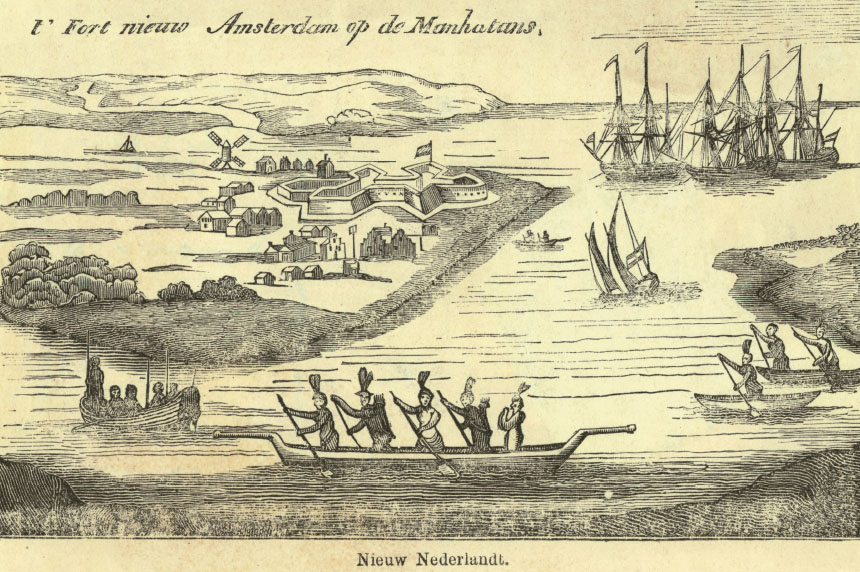Exploring American Histories: Printed Page 40
Exploring American Histories, Value Edition: Printed Page 35
The Dutch Expand into North America
The Dutch, who eagerly embraced the Protestant Reformation at home, made no pretense of bringing religion to Indians in America. From the beginning, their goals were primarily economic. As Spain’s shipbuilding center, the Netherlands benefited from the wealth pouring in from South America. The affluent merchant class that emerged among the Dutch promoted the arts, and artists like Salomon van Ruysdael and Johannes Vermeer in turn captured the importance of trade in their work. But the Dutch also embraced Calvinism and sought to separate themselves from Catholic Spain. In 1581 the Netherlands declared its independence from King Philip II, although Spain refused to recognize the new status for several decades. Still, by 1600 the Netherlands was both a Protestant haven and the trading hub of Europe. Indeed, the Dutch East India Company controlled trade routes to much of Asia and parts of Africa.
With the technology and skills developed under Spanish control, the Dutch decided to acquire their own American colonies. In 1609 the Dutch established a trading center on the Hudson River in present-day New York, where they could trade with Iroquois to the west as well as with Indians who gathered beaver skins along Lake Champlain and farther north. The small number of Dutch traders developed especially friendly relations with the powerful Mohawk nation, and in 1614 the trading post was relocated to Fort Orange, near present-day Albany.
In 1624, to fend off French and English raids on ships sent downriver from Fort Orange, the Dutch established New Amsterdam on Manhattan Island, which they purchased from the Lenape Indians. The new settlement was organized by the Dutch West Indies Company, which had been chartered three years earlier. New Amsterdam was the centerpiece of the larger New Netherland colony and attracted a diverse community of traders, fishermen, and farmers. It was noted for its representative government and religious toleration, which ensured that religious differences did not get in the way of making money.
The European settlers of New Netherland may have gotten along with one another, but the same could not be said for the settlers and the local Indian populations. Tensions increased as Dutch colonists carved out farms north of New Amsterdam where larger communities of Algonquian Indians lived and where European pigs and cattle foraged in Indian cornfields. Algonquians in turn killed and ate Dutch livestock. In 1639 conflict escalated when Governor William Kieft demanded an annual tribute in wampum or grain. Local Algonquians resisted, raiding Dutch farms on the frontier and killing at least two colonists. Then in 1643 Kieft launched a surprise attack on an Indian encampment on Manhattan Island, murdering eighty people, mostly women and children. Outraged Algonquians burned and looted homes north of the city, killed livestock, and murdered settlers. For two decades, sporadic warfare continued, but eventually the Algonquians were defeated.

At the same time, the Dutch eagerly traded for furs with Mohawk Indians along the upper Hudson River. The Mohawks were a powerful tribe that had the backing of the even more powerful Iroquois Confederacy. Their ties to Indian nations farther west allowed them to provide beaver skins to Dutch traders long after beavers had died out in the Hudson valley. Still, the Mohawk people did not deceive themselves. As one chief proclaimed in 1659, “The Dutch say we are brothers and that we are joined together with chains, but that lasts only so long as we have beavers.”
Meanwhile reports of atrocities by both Indians and the Dutch circulated in the Netherlands. These damaged New Amsterdam’s reputation and slowed migration dramatically. Exhausted by the unrelenting conflicts, the Dutch surrendered New Amsterdam to the English without a fight when the latter sent a convoy to oust their former allies in 1664.
Review & Relate
|
How did the Protestant Reformation shape the course of European expansion in the Americas? |
How did the French and Dutch colonies in North America differ from the Spanish empire to the south? |